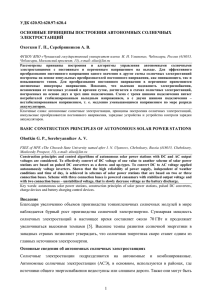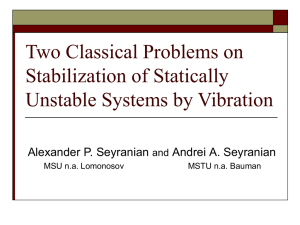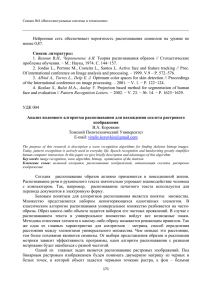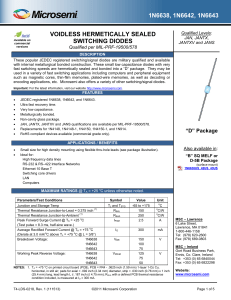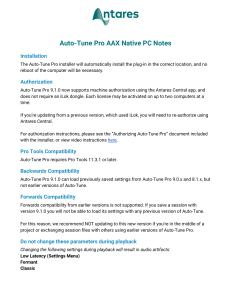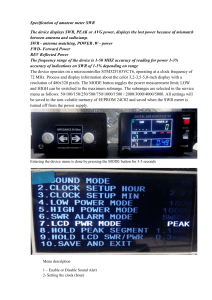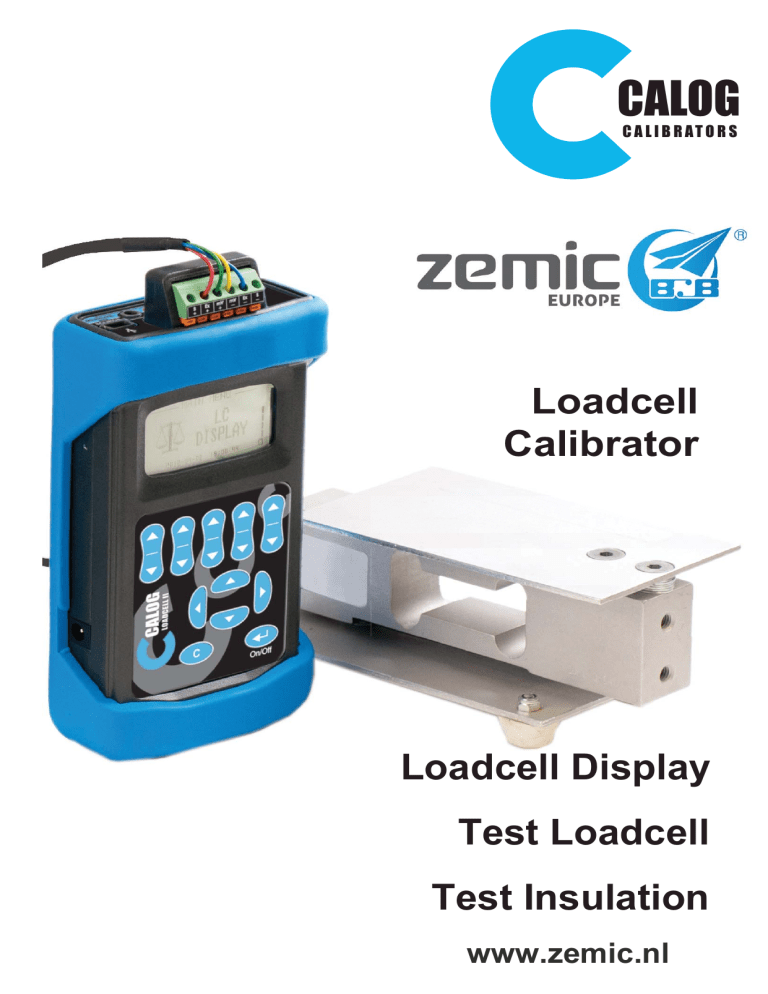
CALOG C A L I B R AT O R S /RDGFHOO &DOLEUDWRU /RDGFHOO'LVSOD\ 7HVW/RDGFHOO 7HVW,QVXODWLRQ www.zemic.nlDFRP Contents 1.0 Introduction ...3 2.0 Getting Started 2.1 Keypad 2.2 Display 2.3 Safety 2.4 Switching On or Off 2.5 Charging the Battery ...4 ...4 ...4 ...5 ...5 ...5 3.0 Flow Diagram ...6 4.0 Wiring Schematics 4.1 Test Loadcell or Loadcell Display 4.2 50V Insulation Test 4.3 Weighing System Measurement 4.4 Weighing System Pre-calibration 4.5 Source Milliamps ...7 ...7 ...7 ...8 ...9 ...10 5.0 Test Loadcell ...11 6.0 50V Insulation Test ...11 ...12 7.0 Weighing System Measurement 7.1 Measure mVdc (and Measure Excitation Voltage) ...12 (and Measure Milliamps) ...13 7.2 Measure mVdc & Mass (and Measure Excitation Voltage) (and Measure Milliamps) 1 8.0 Weighing System Pre-calibration 8.1 Sourcing mV (and Measure Excitation Voltage) (and Measure Milliamps) 8.2 Sourcing mV & Mass or Mass & mV (and Measure Excitation Voltage) (and Measure Milliamps) 2 ...15 ...15 ...16 9.0 Source Milliamps 9.1 Source mA 9.2 Source mA & Mass 9.3 Source Mass & mA ...18 ...18 ...19 ...20 10.0 Loadcell Display ...22 11.0 Datalog ...24 12.0 Datalogging Interface ...26 13.0 Settings ...26 14.0 Maintenance 14.1 Opening your Calibrator 14.2 Changing the Batteries 14.3 Resetting the Unit 14.4 Changing the Fuses 14.5 Battery Care 14.6 Cleaning ...29 ...29 ...29 ...30 ...30 ...30 ...30 15.0 Technical Specifications 15.1 General 15.2 Measuring 15.3 Sourcing ...31 ...31 ...31 ...31 16.0 Accessories ...32 17.0 Other CALOG Products ...32 1.0 Introduction The CALOG - LC II is a hand-held precision calibrator specifically designed for loadcell testing including insulation breakdown and weighing system measurement, electrical pre-calibration or simulation. This unit can also now display a loadcell value. Simply connect a loadcell (or strain gauges in a Wheatstone bridge) to the spring terminals and press ‘test’... The back-lit graphic display will show four or six wire, zero balance, input and output resistance and bridge balance. Connect leads to the housing and screen and press ‘insulation test’ for a 50 volt dc test to display bridge to shield, bridge to housing and shield to housing insulation resistance in megohms. Now that we have the power of L-ion batteries it is possible to use the hand-held calibrator as a loadcell indicator for a reasonable period of time. For longer applications, such as with a cattle scale, auxiliary power can be supplied via an external 12 volt battery, charger or car cigarette lighter socket. In order to display mass, force, strain or torque from loadcells the unit allows you to set the sensitivity in mV/V, range, decimal points and units. Zero trim can offset deadweight and span trim is available to increase the reading accuracy with the help of calibrated weights. Selections of software options such as tare, peak hold and auto zero maintenance are included. The indicator can be used for one 350 Ohm or three 1000 Ohm loadcells with a fixed 5 Volt DC excitation. For weighing system measurement connect the test leads to the loadcell output to show millivolts. Alternatively include excitation measure or value and set up to display mass in a variety of selectable units. The loadcell transmitter output milliamps can also be selected for simultaneous display. Weighing systems electrical pre-calibration can be carried out by injecting millivolts DC into the loadcell transmitter or indicator. By including excitation measurements or value and setting the sensitivity (mV/V) and units the main display can be mass. Output milliamps can also be selected for display. Finally, the calibrator can simulate a loadcell transmitter by injecting milliamps into a loadcell display or scada system. The display can be in mA or set to display mass and output mA. Note : The CALOG - LC II is not suitable for AC or square wave pulse amplifiers. Excitation volts and millivolts are measured and sourced in DC only. 3 2.0 Getting Started 2.1 Keypad These keys change the desired output and are used to set values in the menu Used to change sub menu options. Used to step up or down in the main and sub menus. Enter menu selections or to turn on/off. Go back from run to sub menu to main menu. 2.2 Display The Main Menu (Icon Based) Menu A Submenu (Text Based) Submenu Measuring Millivolts (Power Bar Visible) Primary Display 4 Power Bar 2.3 Safety Your calibrator is not suitable for use in explosive atmospheres. Sparks at the terminals could cause ignition. Test leads with 4mm safety terminals are supplied with the unit Electric shock injury may result from improper use while connected to the mains power supply. To ensure reliability of the unit please use anti-static equipment when working with the circuit boards. 2.4 Switching On or Off Press and hold down the enter key for approx. 2 seconds to switch the unit on. Press and hold down the enter key for approx. 4 seconds to switch the unit off. 2.5 Charging the Battery 1. Connect the lead from the charger into the side of your calibrator. 2. Plug the charger into a AC wall socket. The mains power icon will appear and the power bar will start scrolling if the pack requires charging. 3. When the power bar stops scrolling, remove the charger from the unit and the wall socket. A complete charge will take approximately 5 hours. 4. The charging voltage can be between 8 - 15 VDC with the inner pin as +ve. This means that the CALOG can be charged from a DC source, such as a car cigarette lighter socket using a suitable cable. 5 3.0 Flow Diagram 6 4.0 Wiring Schematics This section shows examples of wiring configurations. These are also found in the Help Menu. 4.1 Test Loadcell and LC Display + + MEASURE mV SOURCE MEASURE mA SOURCE + + From one loadcell. For a 4-wire use terminals 2 to 5(no links) For a 6-wire use terminals 1 to 6 1 2 3 4 5 6 1. Sense + 4. Millivolt - 2. Excitation + 5. Excitation - 3. Millivolt + 6. Sense - 4.2 50V Insulation Test + + MEASURE mA SOURCE + MEASURE mV SOURCE + 1 2 3 4 5 6 1. Housing 4. Millivolt - 2. Excitation + 5. Excitation - 3. Millivolt + 6. Shield 7 4.3 Weighing System Measurement Measure -5 - 35.00mVdc Measure (0-20.000Vdc) Measure (0-24.000mA) mA + + + - + MEASURE mA SOURCE + MEASURE mV SOURCE + + Ex+ CALOG mV- mV+ Ex- Example: Weighing System Measurement Used for measuring loadcell output millivolts from existing operating systems. Connect mV measure from CALOG - L C II to loadcell output and display mV. For mass display also measure excitation voltage (on sense terminals) or set a value for excitation with mV/V and units in the mA&mass submenu. You can then display the loadcell mV as well as the gross mass on the loadcell/s (not excluding tare weight). The mA measurement is optional should you wish to see the mA output from the loadcell transmitter (LCT) whilst measuring mV or mass. Note : mA measure is isolated 8 4.4 Weighing System Pre-calibration mV + Source -5 - 50.000mVdc Measure (0-20.000Vdc) Measure (0-24.000mA) + + + Sense + + MEASURE mA SOURCE - MEASURE mV SOURCE + ℀ + ℀ Used to test or precalibrate loadcell transmitters or indicators Excitation can be measured or set on the keypad Measure excitation on LCT sense terminals for 6-wire system mA - ℀ mV - Sense - Example: Weighing System Pre-calibration Use for electrically pre-calibrating a loadcell system. In the simplest form inject the desired mV after doing all your own calculations. However, the CALOG - LC II can do mV&mass (enter mV mass) or mass&mV (enter mass & display mV) by measuring the excitation (on the sense terminals) or set a value for excitation with mV/V and select units in the submenu. For example: mass&mV, 3 x 1000kg 2mV/V with measured excitation. Select sourcing, submenu select Source: mass&mV , Excitation: measure , mV/V: 02,00 , Unit: kilogram=kg , Zero value: 00000 , Span value: 03000 , Dec point: 00000 , mA measure: on . Connect mV leads from CALOG - LC II into the LCT with loadcell mV disconnected. Connect leads from CALOG - LC II S+ & S- to same on LCT and connect LCT mA in series through the CALOG - LC II mA measure terminals. Now by entering a mass value you should get a corresponding value in mA. Adjust the LCT so that 00000kg = 04,000mA and 3000kg = 20,000mA for example. 9 4.5 Source Milliamps 0 to 24.000mA + + + MEASURE mV SOURCE MEASURE mA SOURCE + ℀ - - + Used to send milliamp signal to control room or to test or calibrate mA input devices In source mA mode the milliamp output changes from measure mA to source mA with 24V DC driving voltage. Ensure receiving end (SCADA, PLC, indicators, recorder, etc.) is a passive input. + ℀ SCADA mA Control Room Example: Source Milliamps Use to send a mA signal to the control room or to test or calibrate milliamps input devices such as indicators, recorder or PLCs. In the simple mA mode you set a value on the display using the value set keys, output is activated immediately. Loop error will flash if circuit open. Should you wish to set a mA value and display the mass equivalent then you must select mA&mass in the sub-menu and enter the mA range, 0 (4)mA value, 20mA value, decimal point and units. If you wish to set the mass value and display the mA equivalent then select mass&mA and enter the same sub-menu values as above. 10 5.0 Test Loadcell Select TEST LOADCELL in the main menu. Connect 4 or 6 wire (no links sense/excitation) Press enter to continue, wait 30 seconds Press enter to return to the main menu. 6.0 50V Insulation Test Select TEST INSULATION in the main menu. Press enter to continue. Disconnect sense wires (if used) and connect leads to housing and shield. Press enter to continue, wait 15 seconds Press enter to return to the main menu. 11 7.0 Weighing System Measurement Select MEASURE in the main menu then press the enter key. 7.1 Measure mVdc (and Measure Excitation Voltage) (and Measure Milliamps) Measure (left or right keys to change) Select mV or mV & Mass (See 7.2) Excitation (left or right keys to change) On measures the excitation voltage (Measure at sense terminals) or Off mA Measure (left or right keys to change) Off or On Measure mV only or Measure mV Measure excitation V Measure mA 12 7.2 Measure mVdc & Mass (and Measure Excitation Voltage) (and Measure Milliamp) Used to display mV and mass from LC system for calibration. (For loadcell display go to LC Display) Measure (left or right keys to change) Select mV & mass. Excitation (left or right keys to change) Measure uses actual value of LC excitation in mass calculation (for high accuracy you must measure on sense connection in six-wire system). Or xx.xxx V allows you to set theoretical value for excitation (max 15.000V) mV/V Set loadcell mV/V from data or nameplate. Unit (left or right keys to change) kg, grams, tonne, oz, lb, or ton Zero Value Set low scale value. 13 Span Value Set high scale value. Decimal Point (left or right keys to change) Move decimal point to suit scale value Milliamps (left or right keys to change) Select off if not required or Select on to measure mA (in series) from LC system amplifier. Press enter when selection completed 14 8.0 Weighing System Pre-calibration Select SOURCE mV in the main menu then press the enter key. 8.1 Sourcing mVdc (and Measure Excitation Voltage) (and Measure Milliamps) Source (left or right keys to change) mV. Sources and displays mV only or mV & Mass. You enter mV and mass is also displayed. (See 8.2) or Mass & mV. You enter mass and mV is also displayed. (See 8.2) Excitation (left or right keys to change) On measures the excitation voltage or Off mA Measure (left or right keys to change) Off or On to measure mA (no 24V loop power) Press enter to source mV Use value set keys to change source mV value 15 8.2 Sourcing mV & Mass or Mass & mV (and Measure Excitation Voltage) (and Measure Milliamps) Source (left or right keys to change) mV. Sources and displays mV only. (See 8.1) or mV & Mass. You enter mV & mass is also displayed. or Mass & mV. You enter mass & mV is also displayed. Excitation (left or right keys to change) Measure (from sense) to display and use in mass calculation or xx.xxxV set to fixed value for display and mass calculation mV/V Set Loadcell mV/V from data or nameplate Decimal Point (left or right keys to change) Select decimal point to suit scale. Zero Value Set low system value for 0mV 16 Span value Set high value. (If 3 x 1 000kg Loadcell = 3 000kg). Unit (left or right keys to change) Select kg or lb, etc. mA measure (left or right keys to change) Off or On to measure xx.xxx mA (from loadcell amplifier output, measure in series). Display for mV & mass Set mV value and mass is also displayed. Display for mass & mV Set mass value and mV is also displayed. 17 9.0 Source Milliamps Select Source mA in the main menu then press the enter key. 9.1 Source mA Display (left or right keys to change) mA display only or mA & Mass. (See 9.2) or Mass & mA. (See 9.3) Range (left or right keys to change) 0-20mA or 4-20mA Function (left or right keys to change) Linear or Flow or Valve Mode (left or right keys to change) Increment or Step or Auto Step or Ramp Main Unit (left or right keys to change) mA or % 18 Loop Power (left or right keys to change) On (24V loop is active) or Off (Simulates mA) Press enter to source mA Use value set keys to change mA value then press enter to output new value (+ Steady) 9.2 Source mA & Mass Display (left or right keys to change) mA. (See 9.1) or mA & Mass (to set mA value and display mass) or Mass & mA. (See 9.3) mA range (left or right keys to change) 0-20mA or 4-20mA Dec Point (left or right keys to change) Select required position for decimal point O(4) mA value: Set to low scale value for 0 (or 4) mA 19 20 mA value: Set to full scale mass value for 20mA Loop Power (left or right keys to change) On or Off Unit (left or right keys to change) Select unit of mass required, eg. kg Press enter Set mA value and mass is also displayed. Use value set keys to change mA value then press enter to output new value (+ Steady) 9.3 Source Mass & mA Display (left or right keys to change) mA. (See 9.1) or mA & Mass (See 9.2) or Mass & mA (to display mass and set mA value) mA range (left or right keys to change) 0-20mA or 4-20mA 20 Dec Point (left or right keys to change) Select required position for decimal point O(4) mA value: Set to low scale value for 0 (or 4) mA 20 mA value: Set to full scale mass value for 20mA Loop (left or right keys to change) On (24V loop is active) or Off (Simulates mA) Unit (left or right keys to change) Select unit of mass required, eg. kg Press enter Display for mass & mA Set mass value and mA is also displayed. Use value set keys to change mass value then press enter to output new value (+ Steady) 21 10.0 Loadcell Display Select LC Display in the main menu then press the enter key. Display (left or right keys to change) LC, will go to final Loadcell display screen or Setup With Setup selected, press enter to enter the information below Configure (left or right keys to change) 4 Wire or 6 Wire Excitation Voltage (left or right keys to change) Output, fixed 5 Vdc to LC or Measure from external excitation or Set 00.00 to 20.000V, theoretical value mV/V Set to sensitivity value on loadcell or datasheet Dec imal Point (left or right keys to change) Display Zero Set zero value 22 Display Span Set span value Unit (left or right keys to change) Select unit of mass required, eg. Kg Increment (count by) (left or right keys to change) 1 or 10 or 100 Filter Band (left or right keys to set band value) 0000 to 9999 If sudden change greater than filter band value display will follow actual value without delay to band value. (use 0000 if you do not want this function) Filter Time Set value for 1, 3, 5 or 10 seconds Zero Trim Use to to tare off deadweight Press enter to trim zero wait 10 seconds to trim After Zero Trim completed goes to Span Trim 23 Span Trim Press enter, load test weights and key in value, press enter to trim span. After approx. 10 seconds the unit reverts back to the top of the LC Display Setup menu. Press enter to go to the display screen. 11.0 Datalog This menu allows the user to setup the CALOG - LC II so it may be used to datalog it’s Loadcell display values. Downloading is done via a SD card and the onboard USB port. Set Date & Time and format the SD Card in the Settings menu before continuing. Please note: Do not remove the SD card whilst Datalogging as this will corrupt any data logged on the SD card By: Use Left and right keys to select block of five characters and use the Set Value keys to scroll This identifies who was responsible for the datalogging Tag: Use Left and right keys to select block of five characters and use the Set Value keys to scroll This identifies the tag number, usually also the plant location 24 Item: Use Left and Right keys to select block of five characters and use the Set Value keys to scroll This identifies the type of instrument, e.g. Cattle scale Start time: Press enter and use up or down arrows and set value keys to change year, month, day, hour, minute and seconds. Press enter to set and return to data logging menu Stop time: Press enter and use up or down arrows and set value keys to change year, month, day, hour, minute and seconds. Press enter to set and return to data logging menu Interval: Use set value keys to set logging intervals H:MM:SS from 01 second to 9H:59M:59Sec Note: Write protect symbol on left of screen when datalogging must be is write protected For instant datalogging whilst in the LC Display mode, insert the SD card and press enter to start and enter to stop. Note, that B y, Tag, Item and Interval will be the same as selected in the Datalog menu 25 12.0 Datalogging Interface After Datalogging is complete, the SD card can be removed from the CALOG - LC II and inserted into a card reader to download the logged data to a PC. Alternatively the .csv files can be downloaded directly from the CALOG via a USB cable plugged into the USB port. The SD card MUST remain inserted in the calibrator. Once downloaded to a PC, the directory is the start date and time. Click once to list the files. Double click to open the .csv file (comma separated variables) Use a suitable program to read the .csv files such as Excel or Open Office. Display the file as a spreadsheet or graph. In Spreadsheet format the text will appear as: Name - Tag - Description - Date and Time - Value ENTER NAME HERE ENTER NAME HERE ENTER NAME HERE ENTER NAME HERE ENTER NAME HERE ENTER NAME HERE ENTER NAME HERE ENTER NAME HERE ENTER NAME HERE ENTER NAME HERE ENTER NAME HERE 12345678901234 12345678901234 12345678901234 12345678901234 12345678901234 12345678901234 12345678901234 12345678901234 12345678901234 12345678901234 12345678901234 INSTRUMENT DESC INSTRUMENT DESC INSTRUMENT DESC INSTRUMENT DESC INSTRUMENT DESC INSTRUMENT DESC INSTRUMENT DESC INSTRUMENT DESC INSTRUMENT DESC INSTRUMENT DESC INSTRUMENT DESC 2010/09/29 2010/09/29 2010/09/29 2010/09/29 2010/09/29 2010/09/29 2010/09/29 2010/09/29 2010/09/29 2010/09/29 2010/09/29 07:06:59 07:07:00 07:07:01 07:07:02 07:07:03 07:07:04 07:07:05 07:07:06 07:07:07 07:07:08 07:07:09 1623 1623 1623 1623 1623 1623 1623 1623 1623 1623 1623 Kg Kg Kg Kg Kg Kg Kg Kg Kg Kg Kg 13.0 Settings This section will let you customise the CALOG - LC II to your personal work style. Auto Power Off (left or right keys to change) On: the unit switches off after 15 minutes of inactivity, or Off: the unit will stay on until switched off or the batteries run flat. 26 Language (left or right keys to change) English or German Backlight (left or right keys to change) On: the backlight stays on constantly, or Auto: the backlight switches off after 30 seconds of inactivity, or Off: the backlight stays off permanently. Sound (left or right keys to change) On: the unit gives audible warnings and confirmations, or Off: the unit is silent. Contrast Press the enter key to gain access to the contrast screen. Use the left and right keys to change the display contrast. When satisfied press enter. Set Date and Time Press Enter 27 Battery Information Press the enter key to view the battery type and voltage level. Type: shows the type of battery which is LIon. Bat Voltage: shows the present voltage in the battery. Nom Voltage: shows the nominal voltage of the battery. Press enter when you are satisfied. Unit information Press enter to view the units serial number, model type, firmware version, the date it was last calibrated and its current temperature. Ser Num: the unit’s serial number. Model: the hardware version of the unit. Firmware Ver: the software version of the unit. Cal Date: the last time the unit was calibrated. Temp: the current ambient temperature of the unit. Enter Access Code Press the enter key to gain access to the access code screen. Use the row of set value keys to change the access code, then press enter. (Used by the factory for calibration) 28 14.0 Maintenance 14.1 Opening your Calibrator There are a few cases in which you may have to open your calibrator. 1. To change the battery pack. 2. To change the fuse. In order to open it, place it face down on a flat, hard surface and unscrew the four screws as shown. Then gently pull the two halves apart. Caution: be very careful not to tear the keypad ribbon or damage the electronics. 14.2 Changing the Batteries If the battery pack fails you must order a new pack from your dealer. Use only the factory supplied lithium Ion battery pack as it contains a temperature sensor. Open the calibrator as shown above and then disconnect the old pack and replace it with the new one. Be careful not to damage the electronics while the unit is open, an anti-static mat and wrist band should be used. Do not force the connector. When you have finished, charge 5 hours. 29 14.3 Resetting the Unit The unit may fail if it passes through a strong electro-magnetic field or is subjected to high voltages or current. In this event there is a reset switch within the unit that should restart it. Press the button through the small hole in the housing (near the power connector) using a paper clip. 14.4 Changing the Fuses The fuses may blow if over ranged. Open the unit to change the fuse. The 250mA input protection fuse, marked F1, can be found at the top left of the sub PCB Take the blown fuse out and replace it with a fuse of the same rating. See 17.0 Accessories for the part number. 14.5 Battery Care Your calibrator is powered by rechargeable Lithium Ion batteries. 1. The batteries can be recharged hundreds of times but will eventually fail. 2. Only use dealer approved batteries that contain a temperature sensor. 3. Do not store your calibrator in extreme heat, above 50ºC as the batteries may become unstable and rupture . 14.6 Cleaning Do not clean the unit while it is switched on. Do not use harsh abrasives or solvents on the unit especially on the display window. The outside of the unit may be safely wiped using a damp cloth. Do not attempt to clean the inside of this unit. 30 15.0 Technical Specifications 15.1 General Physical Size: 147X33X75mm without rubber boot, 155X43X85 with rubber boot. Weight: approx 480 g Environmental Ranges Working temperature: 0ºC to 35ºC Storage temperature (battery included): -10ºC to 50ºC Humidity: 0 to 85% (non-condensing) Battery Pack Type: Lithium Ion (LION) 2100mAH. Charge time: 5 hours. Battery run life: approximately 6 hours. 17.0 Accessories The following items can all be ordered from your dealer or purchased separately. Part Number Item Fuses 250 mA SMD Red Test Lead Black Test Lead Battery Pack (LION) Charger (100 - 240VAC Mains) Charger (12VDC Car Lighter) Rubber Boot Plastic Kit case, with foam 18.0 Other TPC 089 HW 447 HW 448 BA 042 HW 418 + Hw422 RAL-CIG HW 033 HW 180-A CALOG Products CALOG - LOOP II: a milliamp based unit, for the installation and maintenance of all powered and non-powered milliamp loops. SD card for datalogging. CALOG - TEMP: for measurement of thermocouple and Resistance Temperature Detector(RTD). SD card for datalogging CALOG - PRESSURE II: for measuring pressure in the ranges 0 - 3 bar, 0 - 30 bar, or 0 - 100bar. Displays actual value or pressure trend. Contains all CALOG - LOOP II features. CALOG - PRO: the process unit which measure, sources and simulates milliamps, volts, counts and frequency. RALLYTIME GPS: a GPS synchronized rally control and timing device for motor sport. Now with radio and internet linked times. See www.rallytime.co.za CALOG C A L I B R AT O R S www.zemic.nlDFRP

